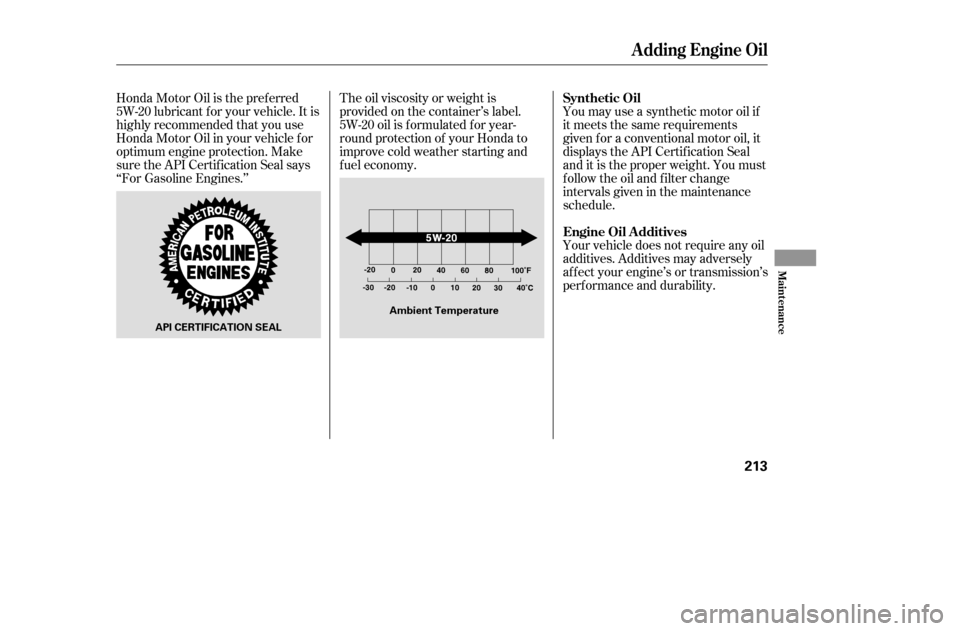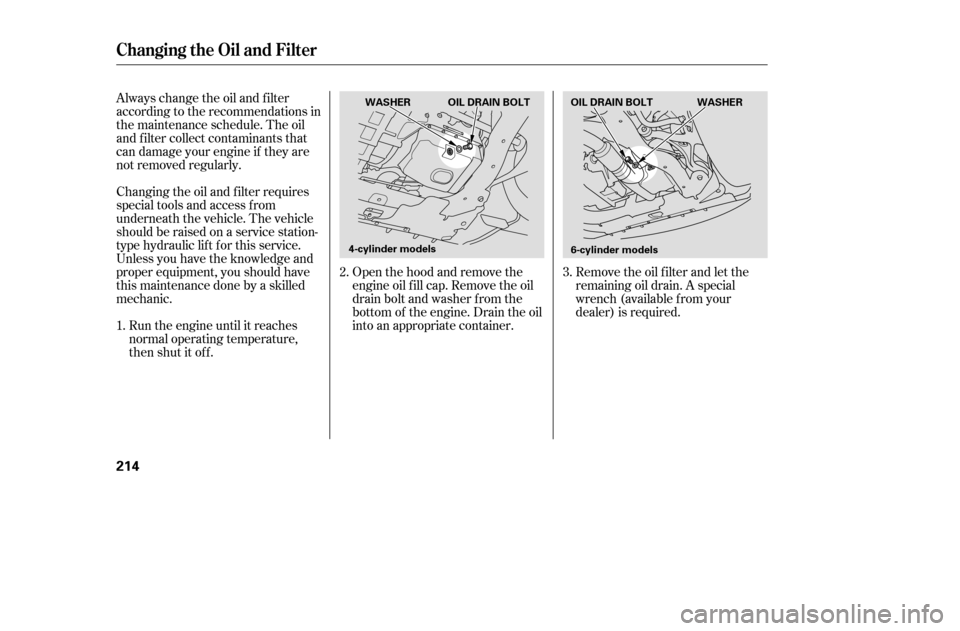Page 200 of 289
(f or Normal and Severe Schedules)Maintenance Record
Maint enance
209
123,750 mi
125,000 mi
127,500 mi
130,000 mi
131,250 mi
135,000 mi
138,750 mi
140,000 mi142,500 mi
145,000 mi
146,250 mi
150,000 mi
198,000 km
200,000 km
204,000 km
208,000 km
210,000 km
216,000 km
222,000 km
224,000 km Signature or dealer stamp mi/km
Date
mi/kmDate
mi/kmDate
mi/kmDate
mi/kmDate
mi/kmDate
mi/kmDate
mi/kmDate228,000 km
232,000 km
234,000 km
240,000 km
Signature or dealer stamp mi/km
Date
mi/kmDate
mi/kmDate
mi/kmDate
�����—�����—�����y�
����
����
�
�y���
�(�����������y�����
���y
Page 204 of 289

Honda Motor Oil is the pref erred
5W-20 lubricant f or your vehicle. It is
highly recommended that you use
Honda Motor Oil in your vehicle f or
optimum engine protection. Make
sure the API Certif ication Seal says
‘‘For Gasoline Engines.’’The oil viscosity or weight is
provided on the container’s label.
5W-20 oil is f ormulated f or year-
round protection of your Honda to
improve cold weather starting and
f uel economy.
Your vehicle does not require any oil
additives. Additives may adversely
af f ect your engine’s or transmission’s
perf ormance and durability.
You may use a synthetic motor oil if
it meets the same requirements
given f or a conventional motor oil, it
displays the API Certif ication Seal
and it is the proper weight. You must
f ollow the oil and f ilter change
intervals given in the maintenance
schedule.
A dding Engine Oil
Synthetic Oil
Engine Oil A dditives
Maint enance
213
API CERTIFICATION SEAL
Ambient Temperature
�����—�����—�����y�
����
��������y���
�(�����������y�����
���y
Page 205 of 289

Remove the oil f ilter and let the
remaining oil drain. A special
wrench (available from your
dealer) is required.
Open the hood and remove the
engine oil f ill cap. Remove the oil
drain bolt and washer f rom the
bottom of the engine. Drain the oil
into an appropriate container.
Always change the oil and f ilter
according to the recommendations in
the maintenance schedule. The oil
and f ilter collect contaminants that
can damage your engine if they are
not removed regularly.
Run the engine until it reaches
normal operating temperature,
then shut it off.
Changing the oil and f ilter requires
special tools and access f rom
underneath the vehicle. The vehicle
should be raised on a service station-
type hydraulic lif t f or this service.
Unless you have the knowledge and
proper equipment, you should have
this maintenance done by a skilled
mechanic.
3.
2.
1.
Changing the Oil and Filter
214
WASHER
4-cylinder models WASHER
6-cylinder models
OIL DRAIN BOLT
OIL DRAIN BOLT
�����—�����—�����y�
����
��������y���
�(�����������y�����
���y
Page 211 of 289
To thoroughly f lush the transmission,
the technician should drain and ref ill
it with Honda ATF-Z1 (Automatic
Transmission Fluid), then drive the
vehicle f or a short distance. Do this
three times. Then drain and ref ill the
transmission a f inal time.Check the f luid level with the engine
at normal operating temperature.Park the vehicle on level ground.
Shut of f the engine.
Remove the dipstick (yellow loop)
f rom the transmission, and wipe it
with a clean cloth.
Insert the dipstick all the way back
into the transmission securely as
shown in the illustration.
The transmission should be drained
and ref illed with new f luid according
to the time and distance recommen-
dations in the maintenance schedule.
If you are not sure how to add f luid,
contact your dealer.
1. 2.
6.
6-cylinder models
T ransmission Fluid
Automatic Transmission
220
DIPSTICK
�����—�����—�����y�
����
������
�y���
�(�����������y���������y
Page 213 of 289

Insert the dipstick all the way back
into the transmission.
The transmission should be drained
and ref illed with new f luid according
to the time and distance recommen-
dations in the maintenance schedule.
If you are not sure how to add f luid,
contact your dealer.
Check the f luid level with the
transmission at normal operating
temperature and the vehicle sitting
on level ground. Remove the
transmission f iller bolt, and caref ully
f eel inside the bolt hole with your
f inger. The f luid level should be up
to the edge of the bolt hole. If it is
not, add Honda Manual
Transmission Fluid (MTF) until it
starts to run out of the hole. Reinstall
the f iller bolt, and tighten it securely.If Honda MTF is not available, you
may use an SAE 10W-30 or 10W-40
viscosity motor oil with the API
Certif ication seal that says ‘‘FOR
GASOLINE ENGINES’’ as a
temporary replacement. However,
motor oil does not contain the proper
additives, and continued use can
cause stif f er shif ting. Replace as
soon as it is convenient.
The transmission should be drained
and ref illed with new f luid according
to the time and distance recommen-
dations in the maintenance schedule.
6.
T ransmission Fluid
Manual Transmission
222
FILLER BOLT
Correct level
�����—�����—�����y�
����
��������y���
�(�����������y���������y
Page 214 of 289

Check the f luid level in the
reservoirs monthly. There are up to
two reservoirs, depending on the
model. They are:Brake f luid reservoir (all models)
Clutch f luid reservoir
(manual transmission only) Always use Honda Heavy Duty
Brake Fluid DOT 3. If it is not
available, you should use only DOT 3
or DOT 4 f luid, f rom a sealed
container, as a temporary
replacement.
Using any non-Honda brake f luid can
cause corrosion and decrease the lif e
of the system. Have the brake
system f lushed and ref illed with
Honda Heavy Duty Brake Fluid
DOT 3 as soon as possible.
The f luid level should be between
theMINandMAXmarksontheside
of the reservoir. If the level is at or
below the MIN mark, your brake
system needs attention. Have the
brake system inspected f or leaks or
worn brake pads.
Replace the brake f luid according to
the recommendations in the
maintenance schedule.
Brake f luid marked DOT 5 is not
compatible with your vehicle’s
braking system and can cause
extensive damage.
Brake and Clutch Fluid
Brake Fluid
Maint enance
223
MAX
MIN
�����—�����—�����y�
����
����
���y���
�(�����������y���������y
Page 216 of 289
�µ�µ
Always use Honda Power Steering
Fluid. You may use another power
steering f luid as an emergency
replacement, but have the power
steering system f lushed and ref illed
with Honda PSF as soon as possible.
A low power steering f luid level can
indicate a leak in the system. Check
the f luid level f requently, and have
the system inspected as soon as
possible.
The timing belt should be replaced
at the intervals shown in the
maintenance schedule. Replace the
belt at 60,000 miles (100,000 km) if
you regularly drive your vehicle in
one or more of these conditions:
In very high temperatures
(over 110°F, 43°C).
In very low temperatures
(under 20°F, 29°C).
Frequently tow a trailer.
6-cylinder models only
Power Steering Fluid, T iming Belt
T iming Belt
Maint enance
225
T urning the steering wheel to f ull lef t
or right lock and holding it there can
damage the power steering pump.
�����—�����—�����y�
����
��������y���
�(�����������y���������y
Page 235 of 289

Leave the parking brake off. Put
the transmission in Reverse
(5-speed manual) or Park
(automatic).
Block the rear wheels.
If the vehicle is to be stored f or a
longer period, it should be
supported on jackstands so the
tires are of f the ground.
Leave one window open slightly (if
the vehicle is being stored
indoors).
Disconnect the battery.Support the f ront wiper blade
arms with a f olded towel or rag so
they do not touch the windshield.
To minimize sticking, apply a
silicone spray lubricant to all door
and trunk seals. Also, apply a
vehiclebodywaxtothepainted
surfaces that mate with the door
and trunk seals.
Cover the vehicle with a
‘‘breathable’’ cover, one made
f rom a porous material such as
cotton. Non-porous materials, such
as plastic sheeting, trap moisture,
which can damage the paint.
If possible, periodically run the
engine until it reaches f ull
operating temperature (the
cooling f an cycles twice).
Pref erably, do this once a month.
Vehicle Storage
244
�����—�����—�����y�
�������������y���
�(�����������y���������y
If you store your vehicle f or 1 year or
longer, have your dealer perf orm the
you take it ou
t of storage (see
pages 202and 204 ). The 6-cylinder
model needs the inspections called
f or in the 2 years/ 30,000 miles
(48,000 km) maintenance schedule
(Normal Conditions) and the 4-
cylinder model needs the inspections
called f or in the 2 years/40,000 miles
(64,000 km) maintenance schedule
(Normal Conditions). The
replacements called f or in the
maintenance schedule are not
needed unless the vehicle has actually
reached that time or mileage.
maintenance inspections as soon as